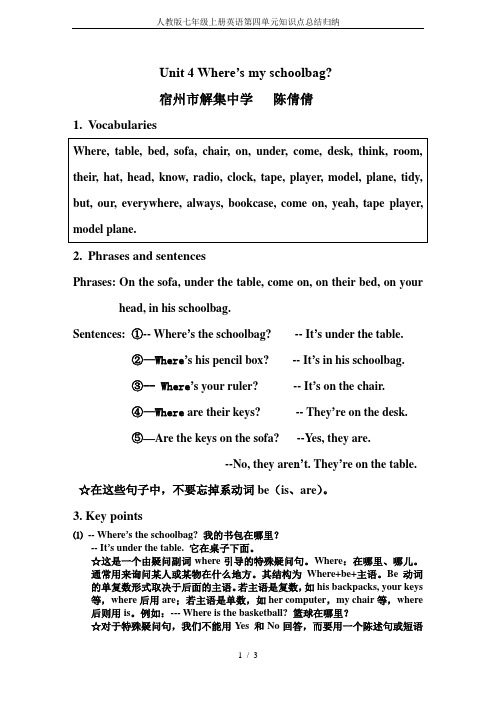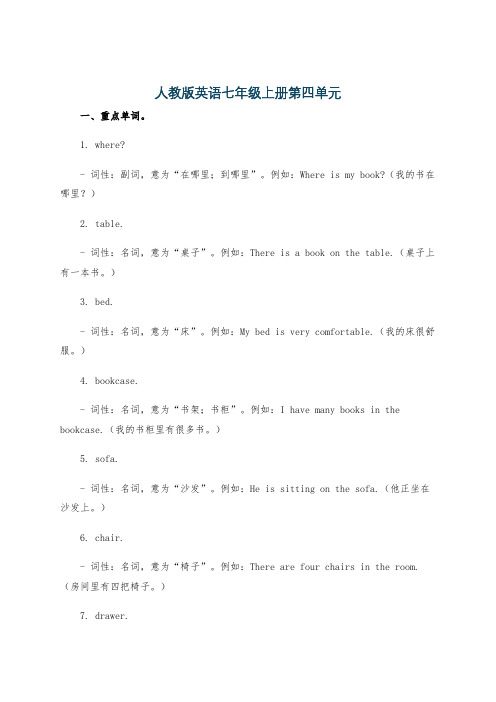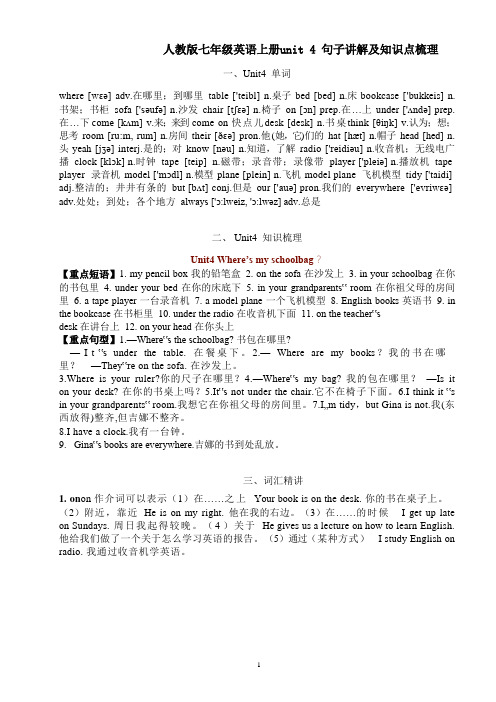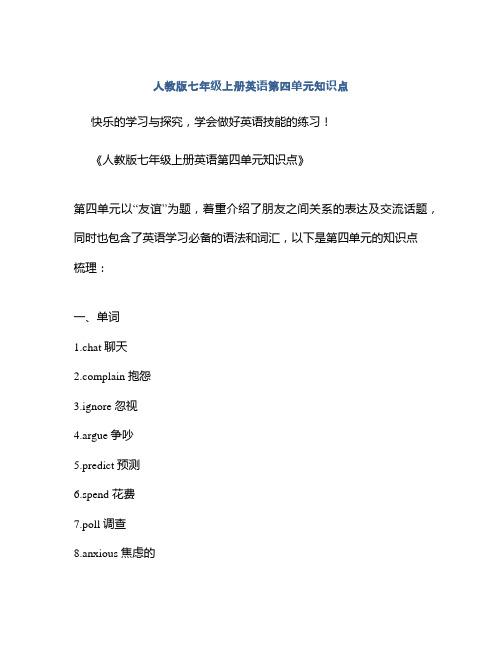人教版七年级上册英语第四单元知识点归纳
人教版七年级上册英语第四单元知识点总结归纳

Unit 4 Where’s my schoolbag?宿州市解集中学陈倩倩1.Vocabularies2.Phrases and sentencesPhrases: On the sofa, under the table, come on, on their bed, on your head, in his schoolbag.Sentences:①-- Where’s the schoolbag? -- It’s under the table.②—Where’s his pencil box? -- It’s in his schoolbag.③-- Where’s your ruler? -- It’s on the chair.④—Where are their keys? -- They’re on the desk.⑤—Are the keys on the sofa? --Yes, they are.--No, they are n’t. They’re on the table. ☆在这些句子中,不要忘掉系动词be(is、are)。
3. Key points⑴-- Where’s the schoolbag? 我的书包在哪里?-- It’s under the table. 它在桌子下面。
☆这是一个由疑问副词where引导的特殊疑问句。
Where:在哪里、哪儿。
通常用来询问某人或某物在什么地方。
其结构为Where+be+主语。
Be动词的单复数形式取决于后面的主语。
若主语是复数,如his backpacks, your keys 等,where后用are;若主语是单数,如her computer,my chair等,where 后则用is。
例如:--- Where is the basketball? 篮球在哪里?☆对于特殊疑问句,我们不能用Yes 和No回答,而要用一个陈述句或短语来作出明确的回答,说明某物在某个地方。
2022年人教版七年级上册英语单元知识点归纳Unit 4 Where’s my schoolbag

Unit 4Where’s my schoolbag?1.where adv.在哪里;到哪里2.3.on prep.在……上4.under prep.在……下e v.来;来到come on 快点儿6.think v.认为;想;思考7.room n.房间8.their pron.他(她、它)们的9.hat n.帽子10.head n.头11.know v.知道;了解12.radio n.收音机;无线电广播13.clock n.时钟14.tape n.磁带;录音带;录像带15.player n.播放机tape player 磁带播放机16.model n.模型17.plane n.飞机model plane 飞机模型18.tidy adj.整洁的;井井有条的→untidy adj.不整洁的;没有条理的19.but conj.但是20.our pron.我们的21.everywhere adv.处处;到处;各个地方22.always adv.总是1.—Where’s the schoolbag?书包在哪里?—It’s under the table.它在桌子下面。
2.—Are the keys on the sofa?钥匙在沙发上面吗?—No,they aren’t.They’re on the table.不,不在。
它们在桌子上。
3.I think it’s in your grandparents’ room.我认为它在你(外)祖父母的房间里。
4.—Where are the pencils?铅笔在哪里?—I don’t know.我不知道。
5.I’m Kate,and my sister is Gina.我叫凯特,我的妹妹叫吉娜。
6.I’m tidy,but Gina is not.我(爱)整洁,但吉娜却不(整洁)。
7.Gina’s books are everywhere—on her bed,on the sofa and under the chair.吉娜的书到处都是——她的床上、沙发上、椅子底下(都有)。
人教版英语七年级上册第四单元

人教版英语七年级上册第四单元一、重点单词。
1. where?- 词性:副词,意为“在哪里;到哪里”。
例如:Where is my book?(我的书在哪里?)2. table.- 词性:名词,意为“桌子”。
例如:There is a book on the table.(桌子上有一本书。
)3. bed.- 词性:名词,意为“床”。
例如:My bed is very comfortable.(我的床很舒服。
)4. bookcase.- 词性:名词,意为“书架;书柜”。
例如:I have many books in the bookcase.(我的书柜里有很多书。
)5. sofa.- 词性:名词,意为“沙发”。
例如:He is sitting on the sofa.(他正坐在沙发上。
)6. chair.- 词性:名词,意为“椅子”。
例如:There are four chairs in the room.(房间里有四把椅子。
)7. drawer.- 词性:名词,意为“抽屉”。
例如:There are some pens in the drawer.(抽屉里有一些钢笔。
)8. plant.- 词性:名词,意为“植物”;也可作动词,意为“种植”。
例如:The plant is very beautiful.(这株植物很漂亮。
)I plant some flowers in my garden.(我在我的花园里种了一些花。
)二、重点短语。
1. under the table.- 意为“在桌子下”。
例如:The cat is under the table.(猫在桌子下面。
)2. on the sofa.- 意为“在沙发上”。
例如:My bag is on the sofa.(我的包在沙发上。
)3. in the bookcase.- 意为“在书柜里”。
例如:All my books are in the bookcase.(我所有的书都在书柜里。
人教版七年级英语上册unit 4 句子讲解及知识点梳理

人教版七年级英语上册unit 4 句子讲解及知识点梳理一、Unit4 单词where [wɛə] adv.在哪里;到哪里table ['teibl] n.桌子bed [bed] n.床bookcase ['bukkeis] n. 书架;书柜sofa ['səufə] n.沙发chair [tʃɛə] n.椅子on [ɔn] prep.在…上under ['ʌndə] prep. 在…下come [kʌm] v.来;来到come on 快点儿desk [desk] n.书桌think [θiŋk] v.认为;想;思考room [ru:m, rum] n.房间their [ðɛə] pron.他(她,它)们的hat [hæt] n.帽子head [hed] n. 头yeah [jʒə] interj.是的;对know [nəu] n.知道,了解radio ['reidiəu] n.收音机;无线电广播clock [klɔk] n.时钟tape [teip] n.磁带;录音带;录像带player ['pleiə] n.播放机tape player 录音机model ['mɔdl] n.模型plane [plein] n.飞机model plane 飞机模型tidy ['taidi] adj.整洁的;井井有条的but [bʌt] conj.但是our ['auə] pron.我们的everywhere ['evriwɛə] adv.处处;到处;各个地方always ['ɔ:lweiz, 'ɔ:lwəz] adv.总是二、 Unit4 知识梳理Unit4 Where’s my schoolbag?【重点短语】1. my pencil box 我的铅笔盒 2. on the sofa 在沙发上 3. in your schoolbag 在你的书包里4. under your bed 在你的床底下 5. in your grandparents‟ room 在你祖父母的房间里 6. a tape player 一台录音机7. a model plane 一个飞机模型8. English books 英语书9. in the bookcase 在书柜里10. under the radio 在收音机下面11. on the teacher‟sdesk 在讲台上12. on your head 在你头上【重点句型】1.—Where‟s the schoolbag? 书包在哪里?—I t ‟s under the table. 在餐桌下。
人教版七年级上册英语Unit 4知识点梳理及语法讲义(教师版)

七年级上册英语Unit 4知识点与语法精讲精练词汇梳理(一)完成单词梳理:名词:1. table桌子 2. bed 床 3. bookcase 书架;书柜4. sofa 沙发5. chair 椅子6. desk 书桌7. room 房间8. hat 帽子9. head 头10. radio 收音机11. clock 时钟12. tape 磁带;录音带13. player 播放机14. model 模型15. plane 飞机动词:1. come 来;来到 2. think 认为;想;思考 3. know 知道;了解代词:1. their 他(她、它)们的 2. our 我们的介词:1. on 在……上 2. under 在……下副词:1. where 在哪里;到哪里 2. everywhere 处处;到处;各个地方3. always 总是连词:1. but 但是形容词:1. tidy 整洁的;井井有条的感叹词:1. yeah 是的;对(二) 词汇变形小结:1. they (人称代词主格:他/她/它们) — them (人称代词宾格) — their (形容词性物主代词:他/她/它们的) — theirs (名词性物主代词:他/她/它们的)2. tidy (adj. 整洁的) — untidy (反义词:不整洁的)3. radio (n. 收音机) — radios (复数)4. we(人称代词主格:我们) — us (人称代词宾格) — our (形容词性物主代词:我们的) — ours (名词性物主代词:我们的)【练一练】用所给词的适当形式填空1.Look! Those are four beds (bed) in my house.rry and I are Bill’s daughters, so Bill is our (we) father.3.Those old CD players ( player) are very nice.4.Susan and Emma thank their (they) teacher for helping them find the keys.5.Tina comes (come) to the gym and plays sports.6.These rooms (room) are too small.7.Look! Your model plane is (be) on the sofa.8.The Chinese book is his (he).9.Look at my mother’s (mother) room. It’s very clean.10.These are their (they) baseballs.(三) 短语攻关:come on快点儿tape player 磁带播放机model plane飞机模型on the sofa 在沙发上in one’s schoolbag在某人的书包里under one’s bed 在某人的床下面on one’s head在某人的头上teacher’s desk 讲桌pencil box 铅笔盒computer game电脑游戏知识点梳理1. Where are my books? 我的书在哪里?【用法详解】“Where+be动词+主语?”该句型为where引导的特殊疑问句,用来询问“某人或某物在哪里?”。
人教版七年级上册英语第四单元知识点

人教版七年级上册英语第四单元知识点快乐的学习与探究,学会做好英语技能的练习!《人教版七年级上册英语第四单元知识点》第四单元以“友谊”为题,着重介绍了朋友之间关系的表达及交流话题,同时也包含了英语学习必备的语法和词汇,以下是第四单元的知识点梳理:一、单词1.chat 聊天plain 抱怨3.ignore 忽视4.argue 争吵5.predict 预测6.spend 花费7.poll 调查8.anxious 焦虑的9.choice 选择10.association 联想二、词组1.chat with sb. 和某人聊天2.make a complaint 发表抱怨3.ignore sb. 忽视某人4.argue with sb. 和某人争吵5.predict the future 预测未来6.spend money on sth. 花钱买某物7.do a poll 作调查8.be anxious about sth. 对某事焦虑9.have no choice 不再有选择10.make an association 产生联想三、句型1.What do you usually do with your friends? 你和朋友们通常做什么?2.Why do you complain about this? 你为何抱怨这件事?3.I hate it when people ignore me. 我讨厌有些人对我不理睬。
4.I often argue with my brother. 我经常跟我弟弟争吵。
5.Do you think it's possible to predict the future? 你认为未来能够预测吗?6.I'm going to spend some money on books. 我打算花点钱买书。
7.Let's do a poll on our favorite food. 让我们做一个关于我们最喜欢食物的调查。
最全面人教版七年级上册英语第四单元知识点归纳总结

Unit 4 Where's my schoolbag?一、词汇与短语● 重点单词A部分1.where adv. 在哪里;到哪里2.table n. 桌子3.bed n. 床4.room n. 房间5.sofa n. 沙发6.their pron. 他(她、它)们的7.chair n. 椅子8.hat n. 帽子9.on prep. 在……上10.head n. 头11.under prep. 在……下12.know v. 知道;了解e v. 来;来到14.bookcase n. 书架;书柜15.desk n. 书桌16.yeah interj. 是的;对17.think v. 认为;想;思考B部分1.radio n. 收音机;无线电广播2.tidy adj. 整洁的;井井有条的3.clock n. 时钟4.but conj. 但是5.tape n. 磁带;录音带;录像带6.our pron. 我们的7.player n. 播放机8.everywhere adv. 处处;到处;各个地方9.model n. 模型10.always adv. 总是11.plane n. 飞机● 重点短语A部分1.on the sofa 在沙发上2.in your schoolbag 在你的书包里3.under your bed 在你的床上e on 快点儿5.on their bed 在他们的床上6.on your head 在你的头上7.under the chair 在椅子下面8.on the sofa在沙发上9.grandparents' room (外)祖父母的房间B部分1.a tape player 一个磁带播放机2.a model plane 一个飞机模型3.under the radio 在收音机下面4.in the bookcase 在书柜里5.on the teacher's desk 在老师的讲桌上6.on the desk 在书桌上7.under the desk 在书桌下8.in my room 在我的房间里● 重点句子A部分1.--Are the keys on the sofa? --No, they aren't. They are on the table.钥匙是在沙发上吗? 不,不是。
人教版七年级上册英语知识点复习:第四单元

人教版七年级上册英语知识点复习:第四单元知识点对朋友们的学习非常重要,大家一定要认真掌握,为大家整理了人教版七年级上册英语知识点复习:第四单元,让我们一起学习,一起进步吧! 一.重点词组 1e of 2 .in the room 3. in the bookcase 4. on the chair 5.under the table 6. I don’t know 7. behind 在……后面 二. 重点句型. 1.Where’s the +东西? -----It’s + on in under + 介词短语 2.Where are your his her + 东西? --- They’re on in under +介词短语 三.知识点 1.介词:是用以放在名词或代词之前,表明该名词与其它词之间某种关系的一类词。
(不能单独使用,需与某一名词或代词等搭配成介宾短语)(on in under)eg: on the bed 2. 定冠词the 的用法: a. 常用在特指的单复数名词前,指某人,某物,某些人或某些物. eg: The students are boys. b . 用于双方都知道的人或物.eg: The girl is my friend. c. 上文提到的人或物,下文再次提到. eg: I have a pen. The pen is red. d. play 后跟球类名词是,不用the. 乐器前一定要用the. ( play basketball play the drums ) 3.. Here is my room. ( here is = this is ) 4.. have has : 表示“拥有” “占有”. eg: I have a computer.。
- 1、下载文档前请自行甄别文档内容的完整性,平台不提供额外的编辑、内容补充、找答案等附加服务。
- 2、"仅部分预览"的文档,不可在线预览部分如存在完整性等问题,可反馈申请退款(可完整预览的文档不适用该条件!)。
- 3、如文档侵犯您的权益,请联系客服反馈,我们会尽快为您处理(人工客服工作时间:9:00-18:30)。
Unit 4 Where’s my schoolbag
宿州市解集中学陈倩倩
1.Vocabularies
2.Phrases and sentences
Phrases: On the sofa, under the table, come on, on their bed, on your head, in his schoolbag.
Sentences:①-- Where’s the schoolbag -- It’s under the table.
②—Where’s his pencil box -- It’s in his schoolbag.
③-- Where’s your ruler -- It’s on the chair.
④—Where are their keys -- They’re on the desk.
⑤—Are the keys on the sofa --Yes, they are.
--No, they are n’t. They’re on the table. ☆在这些句子中,不要忘掉系动词be(is、are)。
3. Key points
⑴-- Where’s the schoolbag 我的书包在哪里?
-- It’s under the table. 它在桌子下面。
☆这是一个由疑问副词where引导的特殊疑问句。
Where:在哪里、哪儿。
通常用来询问某人或某物在什么地方。
其结构为Where+be+主语。
Be动词的单复数形式取决于后面的主语。
若主语是复数,如his backpacks, your keys 等,where后用are;若主语是单数,如her computer,my chair等,where 后则用is。
例如:--- Where is the basketball 篮球在哪里?
☆对于特殊疑问句,我们不能用Yes 和No回答,而要用一个陈述句或短语
来作出明确的回答,说明某物在某个地方。
答句的结构是:主语+be+方位介词+冠词/代词+名词。
例如:It’s under the chair.它在椅子下面。
⑵介词in, on和under
↗介词是一种虚词,在句中不能单独作句子成分。
介词后面一般有名词、代词、冠词或相当于名词的其他词类、短语或从句作它的宾语。
介词和它的宾语构成介词词组,在句中可作状语、表语、补语等。
↗in表示“在……里”,无论在大的范围还是在小的范围内,都要用in。
如The book is in your backpack.那本书在你的书包里。
↗on表示表面上的接触,一个在另一个的上面,即“在……的上面”。
如:An apple is on the table. 一个苹果在桌子上。
↗under表示“在……下”,指在某物垂直的下方。
如:The baseball is under the desk.棒球在桌子下面。
⑶I’m Kate, and my sister is Gina.我是凯特,我的妹妹是吉娜。
▲and意思是“和、与、并、同”,通常用来连接两个并列或对称关系的词、词组或句子。
例如:I help you and you help me. 我帮助你,你帮助他。
▲and连接两个或两个以上的并列成分时,最后两个成分用and连接,其他用逗号隔开。
连接两个或两个以上的单数人称代词时,通常按照“第二人
称、第三人称、第一人称”的顺序。
例如:You, he, and I like English .我、你、他都喜欢英语。
▲and用在good,nice,fine等词之后,表示“很”.如:
The book is good and expensive.这本书很贵。
⑷I think it’s in your grandparents’ room.我认为它在你祖父母的房间里。
※该句是含有宾语从句的复合句。
It’s in your grandparents’ room作think的宾语。
英语中,用一个句子作宾语,这个句子叫做宾语从句。
例如:I think that hat is nice. 我认为那顶帽子很漂亮。
※think是动词,意为“认为;想”。
I think是发表自己的观点或判断,表示“我认为、我想”。
带有不太确切的猜测的语气,是口语中常用的委婉说法。
例如:
I think so.我认为是这样的。
※当think后的宾语从句要表示否定时,习惯上将否定词not转移到think前,称为否定前移。
例如:
I don’t think he is at school.我认为他不在学校。
※grandparents’是名词所有格形式,表示所属关系,意为“祖父母的”
它的构成方法分为单数名词和复数名词两大类,具体见课本86面。
⑸I don’t know.我不知道。
●know是动词,意为“知道、认识”。
例如:I know him.我认识他。
●在回答别人的问题时,如果不知道可以用I don’t know来回答。
使用时习惯
上在前面加上sorry,表示礼貌。
例如:
--Where are my books 我的书在哪里?
--Sorry, I don’t know. 对不起,我不知道。
⑹I’m tidy, but Gina is not.我很井井有条,但是吉娜不是这样。
★tidy是形容词,意为“整洁的、井井有条的”。
例如:
Linda’s room is very tidy. 琳达的房间非常整洁。
★but是连词,意为“但是”,表示转折关系,用来连接两个单词或句子,其前后的词、短语或分句有相对立或对照的关系。
例如:He likes playing basketball
but he doesn’t like playing ping-pong. 他喜欢打篮球,但不喜欢打乒乓球。
⑺Gina’s books are everywhere.吉娜的书到处都是。
→everywhere是复合副词,由every和where合成。
意为“处处、到处、各个地方”。
相当于“here and there”。
例如:
He wants to go everywhere in China.
他想到中国的各个地方去走一走。
→everywhere为副词,它的前面不能接副词。
例如:
The clothes(衣服) are everywhere in her room.
在她的房间里衣服到处都是。
⑻Gina always asks.吉娜总是问。
◆always是表示频率的副词,意为“总是”,其位置常在be动词之后、实义动词的前面。
例如:He is always late for class.他总是上课迟到。
◆asks是ask的第三人称单数形式。
当句子的主语是第三人称单数时,谓语动词要用第三人称单数形式。
动词第三人称单数形式的变化规则与名词单数变复数的规则基本相同。
见课本91面。
例如:She plays sports every morning.她每天上午进行体育运动。
⑼Come on, Jack!快点儿,杰克!
☆come on用于表示催促、鼓励、安慰等,此处表示催促,意为“赶快,快点儿”。
例如:Come on, it’s dark.快点儿,天黑了。
☆come on表示请求、鼓励、劝说等,意为“来吧;行啦”。
例如:Come on, Cindy.
Don’t be shy.来吧,辛迪。
别害羞。
☆用于体育竞赛等场合鼓励队员,意为“加油”。
“Come on! Come on! ” shouted the Class One students.
“加油!加油!”一班的学生大声喊道。
☆用于招呼别人,意为“来、过来”。
例如:
Come on! This way, please. 来,请走这边。
作文部分,认真复习以前讲过的范文,做到多读、多记、多背。
单词是英语的基础和核心,认真记单词。
